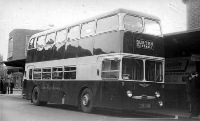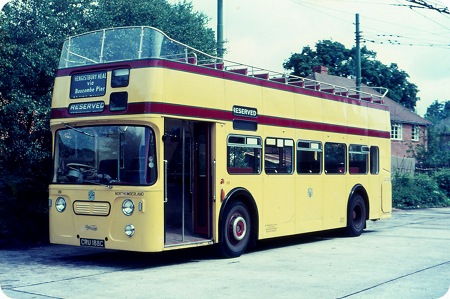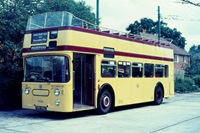Blue Bus Services – Daimler Fleetline – 325 YNU

Photograph by ‘unknown’ if you took this photo please go to the copyright page.
Blue Bus Services
1962
Daimler Fleetline CRG6LX
Northern Counties H40/33F
Blue Bus Services was the operating name of Tailby & George who were located at Willington in Derbyshire.
This bus was the 54th Fleetline chassis built its sister vehicle registration 324 YNU was the first production Fleetline chassis built numbered 60003 the three chassis before were all owned by Daimler and were number 60000 a demonstrator registration 7000 HP, 60001 an experimental chassis and 60002 a demonstration chassis. Blue Bus Services actually purchased the demonstrator 7000 HP after it had done its rounds but unfortunately it and many other buses were destroyed when the Willington bus depot burnt down in 1976.
———
07/03/11 – 09:22
Yes a great loss, I have a rare ring binder bound book on Blue Bus by a small long gone concern known as Morley’s Bible and Book shop, Nottingham Rd, Ilkeston. from about 1978.
Roger Broughton
———
07/03/11 – 16:09
Yes, I remember visiting the shop and knew the proprietor – John Moorley (spelt that way if I remember rightly).
Stephen Ford
———
18/03/11 – 07:55
I worked for Blue Bus for 4 years as an apprentice engineer and left to go to Nottingham City Transport in 1971. It was a fantastic, varied fleet that always looked smart in the hand painted argyle blue and cream livery. Buses were properly cleaned and mopped almost daily, a standard that was probably higher than many current operators achieve nowadays.
If I can help anyone who wants to know anything about the company or their buses I will, just ask, as I was proud to work there, and it set the scene for the vehicle standards I have worked to achieve ever since as an Engineering Director.
Incidentally, my last role was the accountability for engineering and maintenance for a 70,000 bus and coach fleet in the USA and Canada, including the ubiquitous Greyhound fleet. Not bad for a Blue Bus lad from the wilds of Willington!
John Ashmore
———
18/03/11 – 09:16
Big trees from little (blue) acorns grow! Perhaps you could write a potted history for the ARTICLES section – I’m sure we’d all be interested, especially in any amusing incidents.
Chris Hebbron
———
19/03/11 – 07:59
I think that 325 YNU was one of 10 pre production chassis, another of which was PMT L899 which had a virtually identical low height Northern Counties body and was delivered in 1962. L899 had chassis number 60027 which seems a bit high for a pre production chassis but that was what I was told whilst at PMT.
Ian Wild
———
07/05/11 – 18:43
Moorleys shop is certainly long gone but the company survives as a Print and Publishing company. I have retired but still take an interest in the business. Visit //www.moorleys.co.uk for both company history and current titles published.
John Moorley
———
28/01/12 – 08:46
Hi, I wonder if someone could help me. In this thread you mention a bus with the registration 7000 HP. I have found a photo of this bus and my Mum and I believe it could be my Dad driving it. (really exiting if it is as I only have one photo of my Dad)
The bus is in a Street in Sunderland, it is the number 23, destination Roker.
I am just trying to find out what year’s this bus was on the road, and if possibly find out when it was in Sunderland, then we can see if we can match it to the years my Dad was a driver.
I hope someone can help me a little with this.
Many thanks in advance
Lorna
———
28/01/12 – 17:35
Hi Lorna – well, 7000 HP was a Daimler "demonstrator" – ie one loaned to any interested operator to see if they would like to order some after a short trial. If your picture is in Sunderland it is likely to have been on loan to the Corporation for a very short spell – it was new in 1960 and was sold by Daimler in 1966 so the Sunderland loan must have been sometime in that very wide window.
Can anyone narrow it down to a closer date?
Chris Youhill
———
29/01/12 – 16:46
Just to add to Chris’s comment, indeed this vehicle was a demonstrator and went to many operators and spent a considerable time with Birmingham City Transport. The picture here: //www.flickr.com/ and date in text may help further.
Nigel Edwards
———
29/01/12 – 20:21
Lorna, Chris: As 7000 HP was a demonstration vehicle, and the first of Sunderland’s own Fleetlines arrived towards the end of 1962, I would suggest the photo could have been taken in 1961 or 1962.
Bob Gell
———
20/02/12 – 08:54
Hi Lorna
I also have a photo of 7000 HP in Sunderland on route 23 (Thorney Close). It’s in it’s demonstration livery similar to Birmingham Corporation’s, but has Sunderland Corporation showing on the top of the near side windscreen. Unfortunately it is not dated but looks to be 1961 or 1962 as suggested. The engine bonnet cover does not look to be the extended one fitted when a wider Cummins engine was installed as a mobile test bed, so I do not think it was 1965/6, at least.
John Ashmore
———
 Vehicle reminder shot for this posting
Vehicle reminder shot for this posting
———
24/04/12 – 06:42
There is mention several times in these files of Geoff Hilditch. A former boss of mine (in Southampton City Council) once told me a story regarding the advent of the Dennis Dominator. My boss and Mr Hilditch had both worked for the same Council at one time and appear to have still been in contact when the Dominator entered the arena.
I’d have put this entry under the Dennis Dominator, but it doesn’t seem to appear in the menu on the right, so I’ll file it under Daimler instead.
Any readers who want something approaching the truth about how we came to have the Dominator, can find a suitable story on the "Encyclopaedia" website. There are some detail differences between what appears there and what my boss told me, but you’d expect that! Suffice to say that the Dominator was virtually a clone of the Fleetline.
Leyland, for their own reasons, didn’t want to sell Fleetlines to Mr Hilditch in the numbers he wanted to buy, and over the number of years he wanted to buy them. Leyland’s arrogance has been mentioned in these files, and it isn’t just relating to their bus production.
Pete Davies
———
24/04/12 – 09:07
…..but the sad thing is that we all use Leyland as a short hand for British Leyland Motor Corporation who made the proud and historic marque a toxic name and a laughing stock. Even through the bleak years, really good vehicles were produced AN68s, Leopards and Reliances to name but three. Any problems with these were mainly as a result of BLMC ownership which starved Leyland Bus of money for R & D – and possibly quality control. [Tigers, Titans and Olympians were all delayed years because of this starvation.] We can only gasp in astonishment at the arrogance and ignorance that forced the Leyland National Mark 1 on an unsuspecting market and public – and at the expense of the Bristol RE!
David Oldfield
———
24/04/12 – 16:29
Mention of the Dennis Dominator brings to mind the Dennis test bed for this model which was a former Leeds Daimler CVGLX/30 517 7517 UA Dating from 1959 and carrying a Roe body the bus was finished in a red livery and toured operators prior to production commencing.
In its new guise it was re engined and given Voith transmission and a Loline rear axle. It was eventually bought by Leicester for spares.
A fake Dominator visited 10 Downing Street as a publicity event. It was fake because it was actually an East Lancs bodied Atlantean of Brighton with a Dennis nameplate on the front! Of course South Yorks PTE had the largest fleet of Dominators in the UK with 349 buses and the solitary Dennis trolleybus which survives at Sandtoft Museum
Chris Hough
Quick links to the - Comments Page - Contact Page - Home Page


